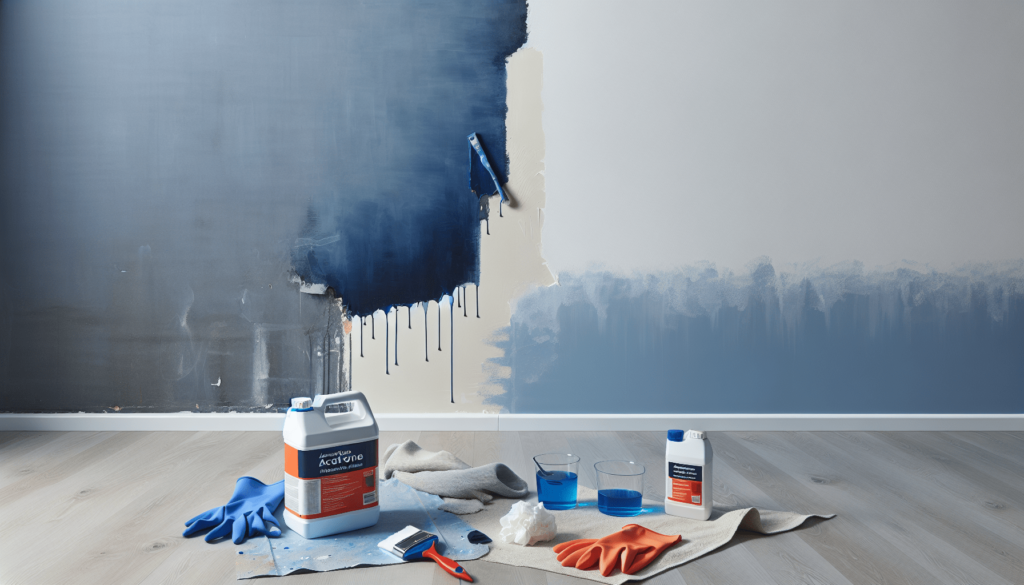Acetone, a highly effective solvent commonly found in nail polish remover, has long been considered a go-to solution for cleaning and removing various substances. However, when it comes to latex paint, one must tread cautiously. The question arises, will acetone successfully remove latex paint? In this article, we will explore the compatibility between acetone and latex paint, analyzing the potential risks and benefits of utilizing this powerful solvent in restoring the pristine condition of your painted surfaces.

Understanding Acetone
Basic characteristics of acetone
Acetone, chemical formula (CH3)2CO, is a colorless, volatile liquid that belongs to the ketone family. It has a distinctive fruity odor and is highly miscible in water. Acetone is a highly flammable liquid with a low boiling point and a high evaporation rate. It is commonly used as a solvent due to its ability to dissolve a wide range of organic compounds.
Common uses of acetone
Acetone finds its application in various industries and household settings. One of its most common uses is as a solvent in the production of plastics, fibers, and pharmaceuticals. It is also widely used in nail polish removers due to its ability to dissolve nail polish quickly. Additionally, acetone is employed in the manufacturing of adhesives, coatings, and paints. It is even utilized in laboratories as a cleaning agent for removing greases and oils from glassware.
Properties of Latex Paint
What is latex paint?
Latex paint, also known as water-based paint, is a type of paint that uses latex or synthetic polymers as binders. It is different from oil-based paints, as it uses water as a carrier instead of organic solvents. Latex paint is known for its quick drying time, low odor, and easy cleanup. It is widely used for interior and exterior applications due to its durability, versatility, and ease of use.
Advantages and disadvantages of latex paint
The advantages of latex paint extend beyond its water-based nature. It offers excellent color retention, resists fading, and is resistant to cracking and peeling. Latex paint also has low levels of volatile organic compounds (VOCs), making it a more environmentally friendly option compared to oil-based paints. Furthermore, latex paint dries quickly, allowing for faster recoating and shorter project completion times.
However, latex paint does have a few disadvantages. It may not adhere well to certain surfaces, such as glossy or untreated wood, without proper preparation. Additionally, latex paints are less resistant to extreme temperatures and may not provide the same level of durability as oil-based paints in high-traffic areas.
Effects of Acetone on Latex Paint
How does acetone interact with latex paint?
Acetone is a powerful solvent that can break down and dissolve many organic compounds, including latex paint. When acetone comes into contact with latex paint, it works by softening and thinning the paint film. This allows the acetone to penetrate the paint layer, making it easier to remove or alter the paint’s appearance.
Possible damage or changes to latex paint
While acetone can effectively remove latex paint, it is important to be aware of potential damage or changes that may occur. Acetone can cause the latex paint to become tacky, soft, or gummy. It may also cause the paint to lose its adhesion to the surface, resulting in incomplete removal or an uneven appearance. In some cases, the acetone may even dissolve the latex paint completely, leaving the surface bare.
Using Acetone to Remove Latex Paint
Precautions and safety measures
Before attempting to remove latex paint with acetone, it is essential to take proper precautions to ensure safety. Acetone is highly flammable and can be harmful if inhaled or swallowed. It is important to work in a well-ventilated area and avoid smoking, open flames, or sparks. Additionally, wearing protective gloves, goggles, and a respirator is recommended to prevent skin and respiratory irritation.
Step-by-step guide to removing latex paint with acetone
-
Prepare the area: Lay down drop cloths or newspaper to protect the surrounding surfaces from any potential spills or splatters.
-
Test a small area: Before applying acetone to the entire painted surface, test it on a small, inconspicuous area to check for any adverse reactions or damage.
-
Apply acetone: Moisten a clean cloth or sponge with acetone and gently dab or rub the painted surface. Allow the acetone to penetrate and soften the paint for a few minutes.
-
Scrape or wipe off paint: Once the paint has softened, use a scraper or cloth to gently lift and remove the softened paint. Be careful not to apply excessive force that may damage the underlying surface.
-
Repeat if necessary: For stubborn or multiple layers of paint, it may be necessary to repeat the acetone application and removal process until the desired results are achieved.
-
Clean the surface: After removing the paint, clean the surface with a mild soap and water solution to remove any residual acetone or paint particles.

Alternatives to Acetone
Other solvents for removing latex paint
If acetone is not readily available or preferred, there are alternative solvents that can be used to remove latex paint. Some commonly used alternatives include denatured alcohol, methyl ethyl ketone (MEK), mineral spirits, and paint strippers specifically formulated for latex paint removal. These solvents work in a similar manner to acetone and can be effective in removing latex paint from various surfaces.
Pros and cons of alternative methods
Each alternative solvent has its pros and cons. Denatured alcohol, for example, is less flammable than acetone and is generally safer to use. However, it may not be as effective in removing stubborn or multiple layers of paint. MEK, on the other hand, is a potent solvent but is highly flammable and poses health risks. It is essential to consider the specific requirements, safety precautions, and potential drawbacks of each alternative method before use.
Considerations for Different Surfaces
Removing latex paint from wood surfaces
When removing latex paint from wood surfaces, it is important to consider the type of wood and any existing finishes or treatments. Acetone and other solvents can strip away not only the paint but also the protective layers or stains applied to the wood. It is recommended to perform a test on a small, inconspicuous area before proceeding with a larger paint removal project.
Removing latex paint from metal surfaces
Metal surfaces require special attention when using acetone or other solvents to remove latex paint. Some metals, such as aluminum or brass, may react with acetone and result in discoloration or damage. It is advisable to use a milder solvent or consult a professional when removing latex paint from metal surfaces to avoid any unintended consequences.
Removing latex paint from walls
Removing latex paint from walls can be a delicate process to prevent damage to the underlying wall surfaces. It is important to start with the least aggressive method, such as gentle scraping or using mild solvents like warm soapy water, before resorting to stronger solvents like acetone. Always follow the manufacturer’s instructions and take precautions to protect the surrounding area.
Tips for Successful Paint Removal
Applying acetone properly
When using acetone to remove latex paint, it is crucial to apply it properly for optimal results. Avoid excessive saturation or soaking of the surface, as it may lead to deeper penetration and potential damage. Instead, apply acetone in small amounts and work in controlled motions to target the paint layer without affecting the underlying surface.
Using the right tools
The use of appropriate tools can greatly enhance the paint removal process. Depending on the size and nature of the painted surface, tools such as scrapers, brushes, or abrasive pads may be required. Selecting the right tools for the job can ensure efficient and effective removal of latex paint without causing unnecessary damage.
Taking care of the surface after paint removal
After successfully removing latex paint, it is essential to properly clean and care for the surface. Use a mild detergent and water solution to remove any residual solvents, debris, or paint particles. Rinse the surface thoroughly and allow it to dry completely before applying any new finishes, coatings, or treatments.
Preventing Paint Spills and Stains
Preparation before painting
To prevent paint spills and stains, adequate preparation before painting is crucial. Cover any surfaces that should not be painted, such as floors, furniture, and fixtures, with drop cloths or plastic sheets. Use painter’s tape to protect trim, baseboards, or other areas that should remain paint-free. Taking these precautions can minimize the risk of paint spills and the need for later removal.
Removing dried latex paint stains
If you encounter dried latex paint stains, removing them can be challenging. However, it is not impossible. Start by scraping off as much of the dried paint as possible using a scraper or putty knife. Then, work on softening the remaining paint with warm soapy water or a suitable paint remover. Gently scrub the area with a brush or sponge until the paint begins to lift. Rinse the stained area thoroughly and repeat the process if necessary until the stains are completely removed.
Understanding Paint Types
Differentiating between latex paint and other types of paint
When it comes to understanding paint types, it is essential to differentiate latex paint from other commonly used paints. Oil-based paints, for example, use organic solvents as carriers and offer different performance characteristics compared to latex paint. Other types of paint, such as acrylic or enamel, may have different chemical compositions and require specific solvents or methods for removal.
Compatibility of acetone with different paint types
While acetone is effective in removing latex paint, it may not be compatible with all types of paints. Acetone can potentially dissolve or damage certain types of paint, such as oil-based paints or some specialty coatings. It is crucial to consider the paint type and consult the manufacturer’s guidelines or professional advice to determine the suitability of acetone or alternative solvents for paint removal.
Conclusion
Summary of findings
Acetone is a powerful solvent capable of removing latex paint. Its ability to soften and dissolve paint makes it a popular choice for paint removal tasks. However, it is important to consider the characteristics of acetone and the nature of latex paint before attempting to remove paint with this solvent.
Latex paint, as a water-based paint, offers advantages such as easy cleanup, low odor, and environmental friendliness. Nonetheless, when exposed to acetone, latex paint can undergo changes, including tackiness, softening, or even complete dissolution.
When using acetone to remove latex paint, precautions and safety measures should be taken to ensure personal safety. Additionally, following a step-by-step guide and considering alternative solvents and surface-specific factors can contribute to successful paint removal.
Final thoughts on using acetone to remove latex paint
Acetone can be an effective tool for removing latex paint. It has the ability to break down and dissolve the paint, allowing for easier removal or alteration of the painted surface. However, it is important to exercise caution and consider the potential risks and effects on different surfaces.
By following proper safety measures, using acetone correctly, and considering alternative methods, successful removal of latex paint can be achieved. With the right tools, techniques, and care for the surface, one can achieve a clean and paint-free outcome.
Remember to always test a small area before proceeding with larger paint removal projects and consult professionals or experts if unsure about the compatibility of acetone or alternative solvents for specific paint types or surfaces.



